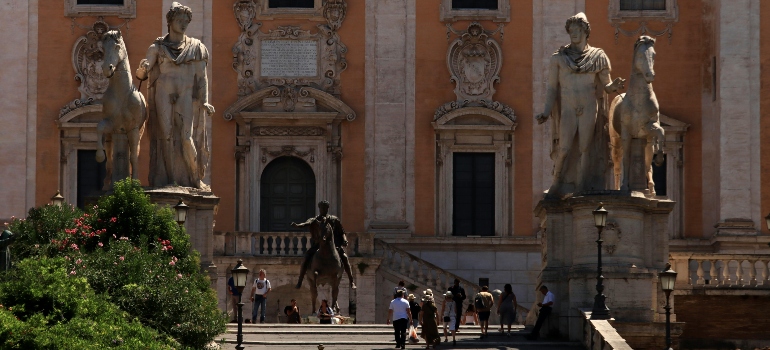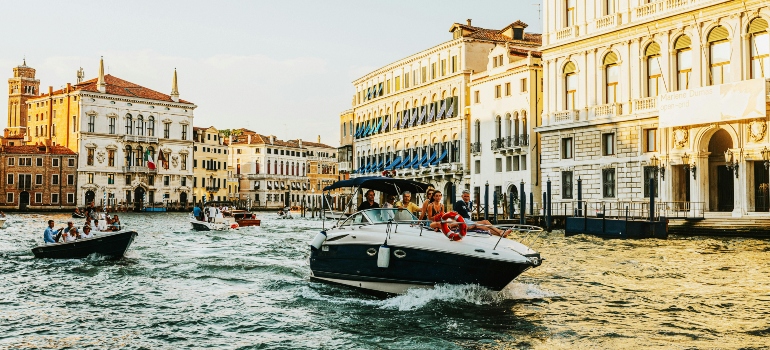Moving to Italy After Holidays – What to Expect?

Get a Free Moving Quote Now!
Start Your International Moving Journey





Moving to Italy after the holidays can spark excitement. Many people dream of living in a place known for art, cuisine, and classic architecture. Holidays bring joy, but a new chapter can begin once they end. This shift can feel both thrilling and daunting. With good planning, the process becomes more manageable. A strong plan helps you handle tasks that come with relocating, such as visa applications or packing possessions. That’s why it’s important to research the “international shipping company near me” to see if they can assist with shipping tasks. Experts in that field handle packing, loading, and paperwork. They can suggest packing materials, schedule shipments, and manage customs, shortening the time you spend worrying about logistics. After the holidays, you can smoothly shift gears. You can focus on landing in a new place, ready to embrace a fresh adventure. This balanced plan helps you keep both practicality and excitement in check. With each piece in its right place, the move feels simpler.
The Appeal of Moving to Italy After Holidays
Moving to Italy offers many rewards. The country presents an immersive experience in art, history, and cuisine. Many visitors flock to museums displaying pieces by Michelangelo, Leonardo da Vinci, and Raphael. Others admire cathedrals and Renaissance structures. These experiences can spark a sense of wonder.
Food is another draw. Each region has signature dishes that highlight local ingredients. Pasta, pizza, risotto, and pastries delight newcomers. People enjoy savoring gelato or tasting wines from regional vineyards. Fresh produce markets also showcase local culture. Chatting with vendors can help build language skills. That sense of warmth can enhance your daily routine. Everyday life can shift in a pleasant way. Even mundane tasks can feel rewarding when set in a new context.

Italy’s climate adds to the appeal. The north sees cooler winters, while the south remains milder. Post-holiday timing might allow you to settle without peak tourist crowds. That can make housing searches easier. Many property owners may have new openings after holiday guests return home. Competition might be lower. You can explore apartments or houses at a comfortable pace. That calmer season can help you save money. Flights might be cheaper, and moving services might offer better schedules.
Another benefit involves logistics. Delays are less common after peak holiday traffic. Your cargo has a smoother route when flights and shipping lanes face fewer travelers. The decision to move at this time can lead to fewer headaches. Scheduling, delivery, and related tasks become simpler. Those advantages show why moving to Italy soon after the holidays appeals to many people.
Key Challenges When Moving to Italy
Relocating to a new country presents obstacles. Proper documents and residency requirements can affect when and how you enter the country. You may need a specific visa to live or work in Italy. That depends on your nationality and intended stay. Consulates or embassies offer detailed guidance. Gathering correct paperwork early avoids headaches. Missing forms can delay plans.
Housing is another concern. Large cities like Rome, Florence, or Milan have higher rent prices. Smaller towns might cost less, but local amenities can vary. Choosing the right city in Italy can make a big difference. Some neighborhoods cater to students, while others suit families or professionals. It helps to research price ranges, local transportation, and safety. Virtual visits through videos or online listings can give a sense of what to expect.
Furthermore, shipping household goods requires attention, too. That includes dealing with fragile items, customs forms, and potential taxes. Each category of goods might need specific papers. Electronics, musical instruments, or antiques sometimes need special clearance. Mislabeling can cause delays or fines. Careful steps ensure your items arrive safe and intact. Planning can protect precious possessions from damage or loss. This approach involves packing carefully and trusting the right transport provider.
Language
Language also matters. Italian is the main language, though English speakers exist in tourist areas. In smaller communities, English might be rare. A language barrier can lead to confusion. Learning basic Italian words builds confidence. Simple greetings, requests, and polite phrases help in stores or cafes. Language skills also show respect for local culture. That can lead to friendlier interactions and support when you need help. Language courses or apps assist with steady progress.

Preparing for Your Move
Moving to Europe from USA often involves a long list of tasks. Focus on early preparation. That increases your chance of success. Begin by outlining your top goals. Do you plan to work, study, or retire in Italy? Each path may require different visas and documents. Research these needs as soon as you decide to move. Early planning prevents last-minute confusion.
An international shipping company can guide you on key steps. They often have experience shipping to Italy. This covers container types, customs duties, and best routes. Ask about shipping timelines. That helps you organize your household goods in a timely manner. Document every item to avoid surprises. If customs officials request details, you can respond quickly.
Packing Supplies
Find strong boxes, bubble wrap, and clear tape. Label each box with its contents. Color coding helps you locate important items first. Some people hire professionals to do the packing. Others prefer to do it themselves to save costs. Either way, well-packed goods face fewer risks. Items like furniture might need disassembly. Keep screws or small parts in labeled bags. That helps you reassemble quickly once you arrive.

A list can help you organize tasks before the moving to Italy after holidays:
- Secure your visa and all necessary documents.
- Arrange airfare and temporary housing in Italy.
- Book an international shipping service that fits your timeline.
- Sort possessions into categories (keep, donate, sell).
- Acquire sturdy packaging for fragile items.
- Store important records in a safe spot.
- Arrange healthcare insurance for your stay in Italy.
- Learn basic Italian phrases to ease daily tasks.
Completing each task in order keeps you on track. This approach lowers stress. Your timeline should also include an arrival buffer. That covers any delays or extra days needed for final packing. If possible, leave a few days free in your schedule. That flexibility can be a relief if something unexpected happens. Good planning keeps you calm. It also ensures you have what you need when you get to Italy.
Shipping and Logistics Tips
Some people worry about shipping large items. Container shipping serves as a practical solution. It allows you to load furniture, boxes, or appliances in one place. Containers vary in size. If you have a full household, a 40-foot container might be suitable. Smaller shipments can fit in a 20-foot container. Experts can suggest the right choice. That depends on how much you plan to take.

Delivery options include port-to-port or door-to-door. Port-to-port means you handle transport on both ends. This might mean renting a truck or hiring help to move items from the port to your home. Door-to-door service covers pickup and final delivery, though it costs more. Balance cost and convenience when deciding. Think about your own capacity for heavy lifting or local transport. Professional movers often handle special items, like pianos or artwork, with extra care.
Hiring professionals means you get support for customs paperwork. That speeds up clearance. These specialists already know the required forms and local fees. Their familiarity with shipping routes helps you avoid wrong choices. Timely shipments keep you from paying storage charges. Professional handling leads to fewer complications.
Settling in Italy After the Move
Once you arrive, daily tasks need attention. Registering with local authorities marks the next step. That can involve filling out forms at city halls and obtaining a residence permit. These tasks are important to remain legally in the country. Some municipalities require you to apply within a certain time window. Missing that deadline causes complications. Take note of deadlines and complete them soon after you land.

Utilities also need setting up. Water, gas, electricity, and internet connections form part of everyday life. You might find that service providers speak limited English. Having a basic grasp of Italian goes a long way. Ask friends or neighbors for tips on reliable providers. Look for promotions that suit your budget. If you rent, your landlord might handle some of these tasks. Clarify who manages each utility to avoid confusion.
Valuable Things
Some families bring valuable instruments. For such cases, an international piano movers service can make sense. They know how to protect delicate parts during transit. Wooden surfaces, strings, and internal parts need extra padding. The same goes for antiques or fine art. If you hire experts, ask about their past experience and references. Proper crating prevents damage and stress.
Opening a bank account is next. Each bank has different requirements, such as proof of address or a residency permit. These accounts can help you pay bills and receive local payments. Credit cards or checks from your home country might not work for certain local transactions. Research bank fees and services. Some banks cater more to international clients. Choose the one that fits your needs.
Everyday life in Italy can feel different. People often gather in communal areas. The local pace might seem slower in some parts of the country. Adjusting to life in Italy takes time, but learning how to greet locals and join conversations helps you settle in. Consider local events or groups for newcomers. Shared interests create friendships. An open mind and a willingness to learn can smooth your first months.
Moving to Europe from the USA: Lessons Learned
Many who choose to move to Europe from the USA share stories that show where they succeeded or struggled. Some discover a love for small-town charm in Italy. Others face challenges in big cities. Listening to personal experiences can guide you. Learn from mistakes to ensure your move unfolds more smoothly.
A major lesson involves timing. Avoid big holidays unless you enjoy crowds or high prices. Tickets and accommodations might spike in cost. Some moving services also face scheduling overload. Planning around off-peak seasons often lowers costs and hassle. This is why moving soon after big celebrations can make sense.
Another lesson concerns the packing supplies you’ll need for your international move. Make sure you invest in strong containers. Delicate or valuable goods may need extra protection. Keep a list of each box and its contents. That helps with insurance claims if something goes missing. Also, note that certain electrical items might not work without adapters or converters. Save space for them in your luggage or buy them after arrival.

Budgeting is a common struggle for new arrivals. Some miscalculate living costs, especially in famous cities. Research average grocery prices, utility bills, and transportation costs. Property taxes or home insurance might also vary. That can help you avoid surprises. It’s smart to have an emergency fund for the first few months. Unexpected fees, repairs, or other costs often pop up. With a buffer in your account, you’ll worry less.
Last, many newcomers underestimate the language barrier. English works in some tourist spots, but you’ll need Italian for full immersion. Language schools or online lessons can boost your confidence. Locals appreciate even small efforts. Engaging with neighbors helps build friendships. Over time, you’ll gain fluency and integrate more deeply.
Моving to Italy After Holidays
Moving to Italy after holidays can feel exciting. Proper planning and services like container shipping can simplify the journey. You might need visas, shipping solutions, and a plan for daily life. Each step, from packing to settling, requires focus. Sorting out logistics with specialists makes the move more relaxed. The season after major celebrations often has fewer crowds, fewer shipping delays, and possible cost savings. Follow your plan, stay open-minded, and keep track of important tasks. Soon enough, you’ll settle in and create lasting memories!
